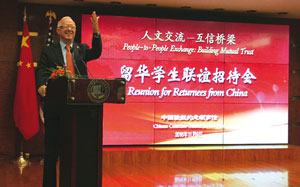Report: China-US investment ties bigger than thought
While China-US economic relations under the next US administration have been the topic of much speculation lately, a report released on Monday showed that bilateral investment ties are far stronger and hold greater potential than most people realize.
The report, Two-Way Street: 25 Years of US-China Direct Investment, is a study by the National Committee on US-China Relations (NCUSCR) and Rhodium Group, which tracks Chinese foreign direct investment (FDI) in the US.
Based on its own novel dataset, the study finds that the commercial stakes on both sides are two- to four-times higher than commonly used statistics suggest.
While China’s official statistics put the Chinese FDI stock in the US at $41 billion (twice the official US estimates of $15 billion to $21 billion), the study counted 1,200 individual transactions between 1990 and 2015 with a combined value of $64 billion.
The same goes for US FDI in China. Unlike the US Bureau of Economic Analysis’ figure of $75 billion in stock of US FDI in China as of 2015 — and China’s Ministry of Commerce’s number of $70 billion — the study counted some 6,700 US investments in China with a combined value of $228 billion.
“We hope this is another contribution we can make to bringing more transparency in US-China investment relations,” said Thilo Hanemann, director of Rhodium’s cross-border investment practice and one of the authors of the report.
The data show that while some Americans are eager to talk about imposing reciprocity requirements for inward Chinese FDI, the cumulative value of US FDI transactions permitted in China to date is four times that of China in the US.
While many Chinese complain about the lack of openness in the US, the data show that the US is open and welcoming to Chinese investment, and that Chinese companies are now investing more in the US annually than US companies are in China.
These observations emphasize that both sides need to reconsider the data before staking out new policy positions, according to the report.
The study also finds that benefits from FDI are huge for both sides, mostly at local levels. US companies now employ 1.6 million workers in China, while Chinese FDI in the US at an earlier stage has already created more than 100,000 US jobs.
Steve Orlins, president of the NCUSCR, said that unlike trade, which has been controversial in the US election, investment creates jobs.
He recalled a trip four weeks ago to Dayton, Ohio, where Chinese company Fuyao Glass opened the world’s largest automotive glass facility in a closed GM factory, hiring more people than the previous GM factory had.
“I watched the rebirth of the community. That’s part of what this story is today,” Orlins said.
The new study also finds the new picture of US-China FDI differs from the previous two decades, in terms of industry patterns, motives and investment composition. For example, US investment in China has shifted from the early days of seeking lower manufacturing costs to consumer-oriented objectives.
It said that US-China bilateral investment is nowhere near saturation. “Chinese companies have just started to operate overseas” while “US companies are more than ready to increase investment in China, especially to engage the Chinese consumer and compete in growth sectors such as healthcare, research and development and modern services.”
“The assumption that FDI flows to China have peaked because it is wealthier today is mistaken,” the report said.
Kenneth Jarrett, president of the American Chamber of Commerce in Shanghai, cited a survey early this year that shows that 80 percent of its members said they would increase their investment in China in 2016.
He said the new report came at an important juncture “as we contemplate what the agenda for the incoming Trump administration will be.”
Jarrett said much work has been done on the Bilateral Investment Treaty (BIT) between China and the US, and hoped it would be a valuable policy objective for the new administration as well. He argued that in the BIT, China will give much more than the US, because the US investment environment is quite open already.
There has been widespread concern whether or not BIT negotiations will still be viable in the Trump administration given the fate of the Trans-Pacific Partnership, which Trump and the new Congress have decided to put to death.
“President Trump talks about good deals and bad deals. This would fall into the category of good deals,” Orlins said of the BIT between China and the US.
John Wadsworth Jr, co-founder of Manitou Ventures, described the BIT as “the biggest opportunity on earth for financial services.”
In Washington on Nov 21-23, China and the US will meet for the 27th session of their Joint Commission on Commerce and Trade, with the Chinese delegation led by Vice-Premier Wang Yang and the US team led by Commerce Secretary Penny Pritzker and US Trade Representative Michael Froman. The annual meeting, first launched in 1983, will address bilateral investment and trade issues.
chenweihua@chinadailyusa.com






















